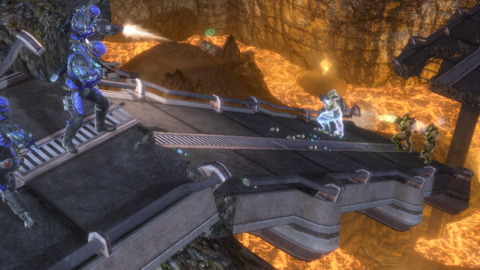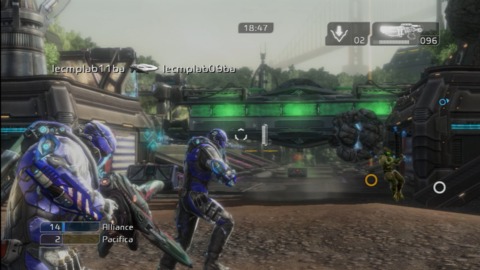
If anything, Fracture's terrain-fiddling actually seems more suited to a multiplayer environment; it turns out there's a lot of interesting things you can do with those abilities when you're using them to advance team objectives or just kill a lot of people. In every multiplayer mode you start out with three types of grenades: one that raises terrain, one that lowers it, and one that superheats the ground and causes a big fat spike of semi-molten rock to shoot up. The upside to the grenades is, they have splash damage that will hurt anybody nearby when they go off. The downside is that you have to wait a few seconds for the grenade to fly and detonate, so you can't really pull off split-second terrain mods as combat demands.
That's where the Entrencher comes in. It's a rechargeable weapon that can raise and lower the ground just like the grenades, but it does it instantly wherever you aim it. You don't get the damage of the grenades, though, so you can't kill people with it. Two or three discharges will totally deplete its energy, so you can't be spamming craters or hills everywhere, but the Entrencher does open up some interesting moves and strategic options unique to multiplayer. For instance, if a guy is directly under some static geometry, you can launch the ground upwards to crush him underneath it and get an instant kill. One of the team-based maps had rivers of toxic slime running across them, and you can use the Entrencher to make a bridge of rock pop up in the middle of this if you don't feel like running over and hopping on the premade bridge. Raising the ground is obviously useful when you can't reach a higher surface, but you can also double-tap the jump button to automatically raise the ground right underneath you to launch you way up in the air, sort of like a rocket jump.

Some of the regular weapons I tried didn't seem to pack much punch, especially the default rifle. But I did like the vortex grenade, which basically turns into a black hole that sucks in everything and everybody nearby and sends them spinning around in a crazy circle. There are a few other interesting weapons, like a tunneling mine launcher that shoots projectiles which burrow under the ground and under some obstacles. On the whole, the weapon array seemed a little hit-and-miss, though.
After a bunch of people have run around the map making mountains and craters everywhere, the map ends up looking pretty messy. Luckily, the terrain deformation seems to interact with the static pieces of the level pretty realistically. For instance, I tried raising and lowering the ground underneath a gigantic concrete slab just to see how this worked, and it would knock the slab around and raise it up on its end in a pretty believable way. You can only deform natural terrain like rock; man-made stuff like concrete or iron grating is static.
Fracture is due on shelves October 7.